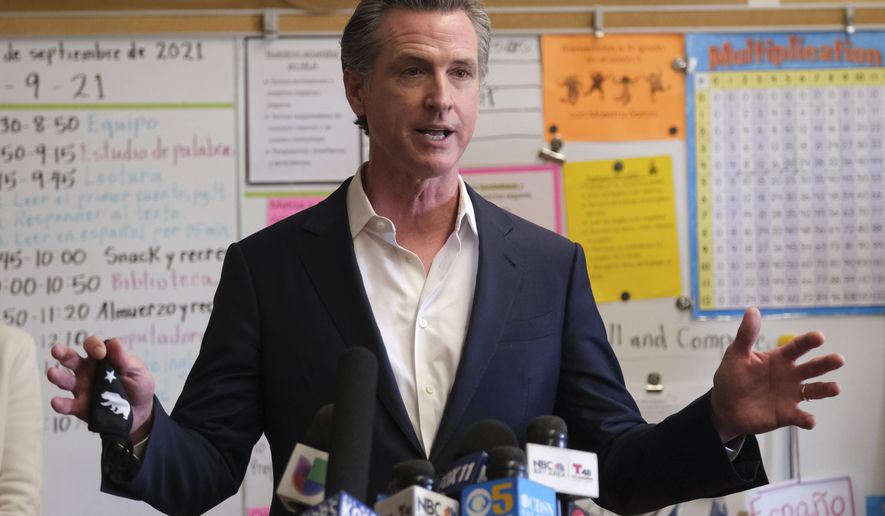For California Democrats, one of the lessons from the failed recall of Gov. Gavin Newsom is that the state should make it tougher to recall governors.
Democratic state Sen. Steve Glazer and Assemblymember Marc Berman announced Wednesday they plan to hold hearings in the next few months to “fix a broken system” with the goal of proposing revisions to the “flawed recall” structure during the 2022 legislative session.
“Now that the recall is over, I believe it is time to re-evaluate and update California’s recall process,” Mr. Glazer said in a press release. “The voters want to see a more democratic process put in place that keeps elected officials accountable, but prevents political gamesmanship of the rules.”
Meanwhile, the pro-Democrat advocacy group Indivisible Ventura launched a “Reform the Recall” campaign to address California’s “recall madness” after the Sept. 14 special election, describing it as a “GOP temper tantrum.”
At the top of the Democrats’ to-do list is changing the rule that allows the ousted official to be succeeded by the replacement candidate with the most votes, even if the challenger receives less than the majority of the vote or fewer votes than the recall target.
“California law should not allow someone else to be recalled and replaced by a candidate who receives far fewer votes,” Mr. Berman said in a statement.
Republicans pointed out that Democrats already have reworked the rules: Ahead of the 2018 recall of Democratic state Sen. Josh Newman, the state legislature passed measures giving state officials more latitude in drawing out the recall date and petition-signers 30 days to remove their names.
“What do you do when you don’t like the rules? You try to change the rules,” state Republican National Committeewoman Harmeet K. Dhillon said on Fox Business. “They don’t like the game. He already changed them a couple of times, when Democrats were at risk of losing a Senate seat from a recall.”
She said the 2017 legislative changes helped Mr. Newsom by allowing his lieutenant governor to schedule the recall for September.
“In this case, he benefited from the anticipated deadline for the recall by moving it up two months so that he was able to run in September and not November, when the situation was likely to be more oppressive with Covid restrictions,” Ms. Dhillon said.
Assemblyman Kevin Kiley, one of the Republican recall candidates, brought up the provision allowing the recall target to raise unlimited funds, which permitted the anti-recall camp to outraise the opposition by an estimated 5 to 1.
“Newsom’s allies are already moving to ’fix’ the Recall process,” Mr. Kiley tweeted. “I wonder if that includes the quirk of unlimited campaign contributions that allowed him to flood our TV screens with what the AP called out as lies.”
Translation: Crush the rebels! https://t.co/BQvVzuu4ce
— Carl DeMaio (@carldemaio) September 15, 2021
Ironically, California’s 1911 recall law was instituted by a leftist, Gov. Hiram Johnson of the Progressive Party, but the law in recent years has been used almost exclusively against Democrats, who hold veto-proof supermajorities in both legislative houses and control all elective state offices.
Among the proposed changes being sought by Indivisible are rules that would replace a recalled governor with the lieutenant governor, instead of a replacement candidate; allow the recall target to run to replace himself; and require “just cause” for a recall.
Other ideas include raising the signature limit, which is currently 12% of the votes cast in the last gubernatorial election, and increasing the initial filing requirement of $4,000 and 65 signatures.
A UC Berkeley Institute for Governmental Studies poll released Monday found that 75% favor retaining the recall but also found majority support for several changes, including a runoff system if no replacement candidate receives the majority of the vote.
California voters rejected Tuesday’s recall by 63.8% to 36.2%, according to the latest count, or roughly the same percentage that elected Mr. Newsom in 2018.
Critics argue that even under the current rules, recalling a state officeholder is still an uphill battle.
There have been 55 gubernatorial recall attempts since 1911, and only two of them have qualified for the ballot: the 2021 Newsom recall, which failed, and the 2003 recall of Democratic Gov. Gray Davis, which passed.
Of the 179 recall attempts for all officeholders since 1913, only 11 have qualified for the ballot. Six of those were successful, according to the California Secretary of State’s office.
The Democrats’ Mr. Glazer and Mr. Berman argued that political operatives in recent years have taken advantage of the system.
“More than 70% of the attempts to recall elected state officials that have qualified for the ballot, including the only two statewide recall elections in California history, have occurred in the last 27 years,” they said in a press release. “Each of California’s last nine Governors has faced multiple recall attempts, though only two of those attempts have qualified for the ballot.”
Before Tuesday’s vote, the state finance department estimated the cost of the Newsom recall at $276 million, although state officials say the final cost may reach $300 million.
• Valerie Richardson can be reached at vrichardson@washingtontimes.com.




Please read our comment policy before commenting.